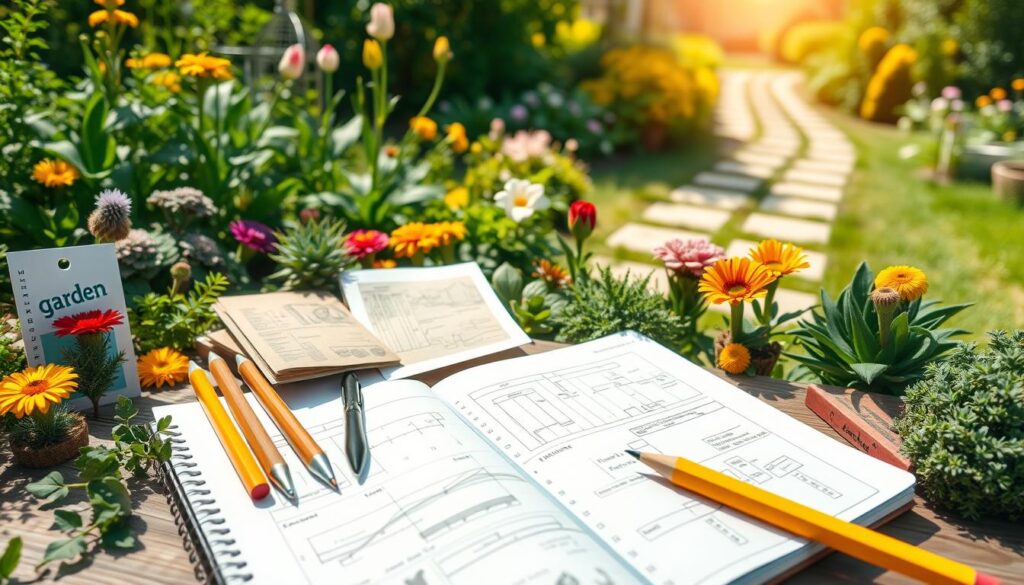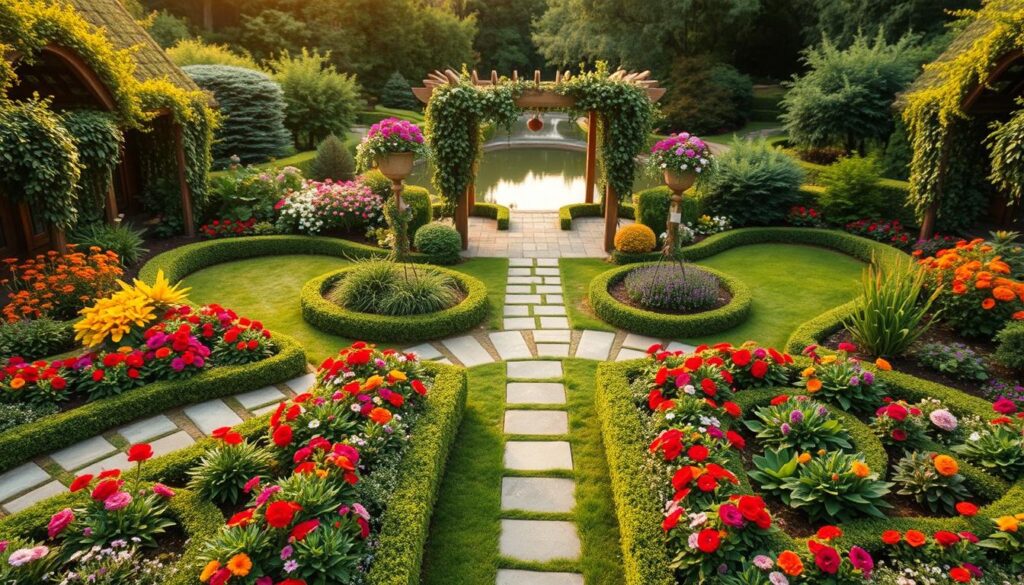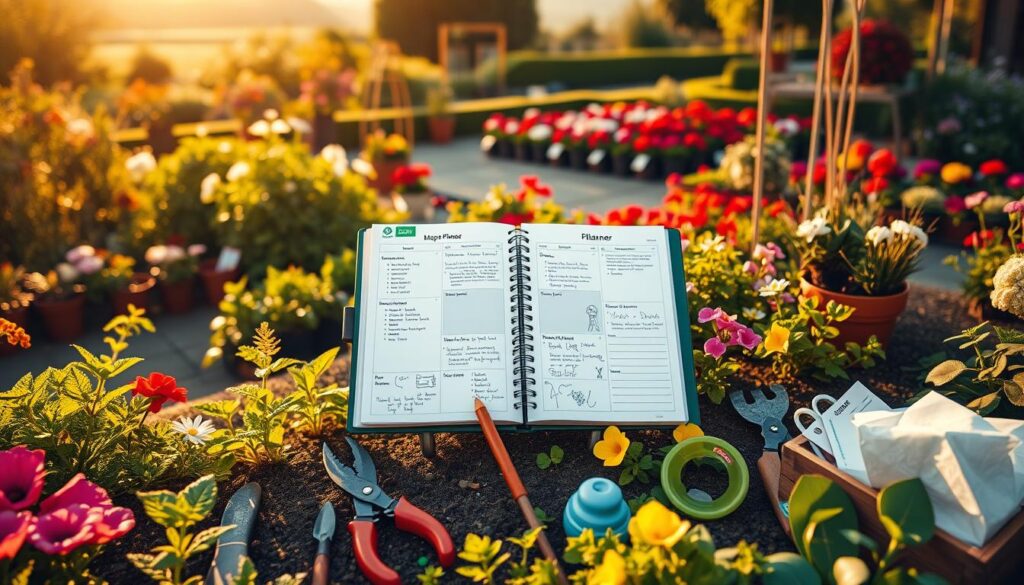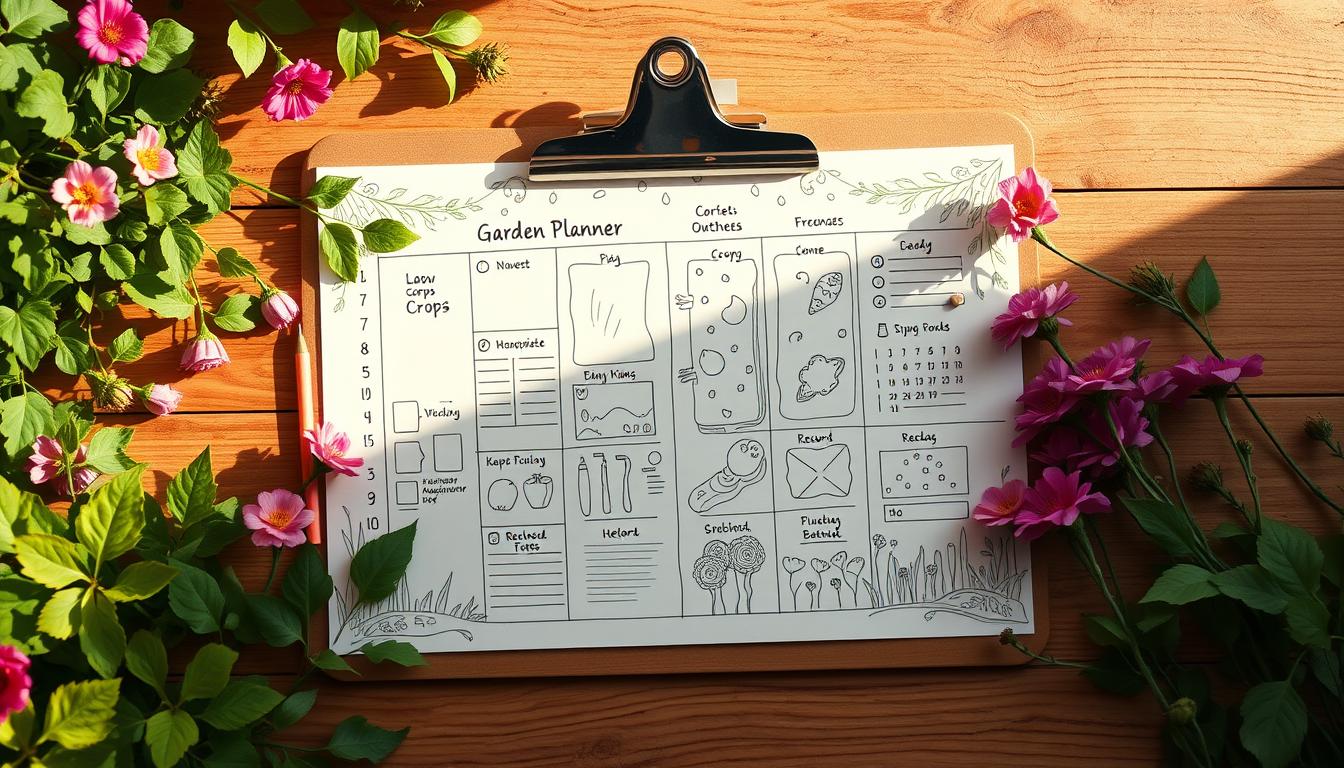Organizing your outdoor space can feel overwhelming, especially when juggling multiple tasks. A garden planner simplifies the process, helping you stay on track and achieve your goals. With a printable garden planner, you gain access to a 38-page customizable tool designed for efficiency.
This free printable garden resource is available for immediate download, making it perfect for spring preparation. It’s binder-compatible, ensuring you can use it year after year. Whether you’re a beginner or an experienced gardener, this planner offers visual mapping and a companion tools list to streamline your efforts.
Key Takeaways
- Customizable 38-page planner for organized gardening.
- Immediate download for quick spring preparation.
- Binder-compatible for multi-year use.
- Includes a companion tools list for added convenience.
- Visual mapping features for better layout planning.
Why You Need a Garden Planner
Planning your outdoor space doesn’t have to be stressful—it can be fun and rewarding. A garden planner helps you stay organized, ensuring your plants thrive and your efforts pay off. Whether you’re a beginner or an expert, having a clear strategy saves time and reduces mistakes.

The Importance of Planning Your Garden
Without a plan, it’s easy to forget what you’ve planted or where. This can lead to what some call “garden trauma”—overgrown areas or missed opportunities. A planner helps you track every detail, from seed quantities to crop rotation. It also ensures you don’t waste money on duplicate purchases, saving you $75 or more.
Benefits of Using a Printable Garden Planner
Using a planner offers several advantages:
- Track microclimates: Identify areas in your space that need special attention.
- Align with frost dates: Reference USDA hardiness zones to schedule planting perfectly.
- Historical records: Keep notes on what worked and what didn’t for future seasons.
With these tools, you’ll have everything you need to create a thriving and organized space.
Getting Started with Your Garden Planner
Starting your gardening journey with a planner ensures clarity and efficiency. This resource helps you map out your space, track progress, and achieve your goals. Whether you’re planting vegetables, herbs, or flowers, a planner keeps everything in one place.

Downloading and Printing Your Planner
Begin by downloading your free printable planner. For durability, use 32 lb paper, especially if you’ll be working in wet conditions. This ensures your pages stay intact throughout the season.
Consider adding color-coded page protectors for an artistic touch. They also help organize sections like planting schedules and seed catalogs. Grid paper can be matched to your bed dimensions for precise mapping.
Essential Tools to Complement Your Planner
Pair your planner with tools that enhance your gardening experience. Here’s a quick guide:
| Tool | Purpose |
|---|---|
| Oscillating Sprinkler | Ensures even watering for all plants. |
| Miracle-Gro Feeding Schedule | Provides monthly reminders for plant nutrition. |
| Washi Tape | Helps divide sections by season or type. |
| Seed Catalogs | Offers inspiration and variety for planting. |
Integrating these tools with your planner creates a seamless gardening experience. You’ll stay organized and prepared for every step of the process.
How to Use the Ultimate Printable Garden Planner
A well-structured approach to gardening ensures success and reduces stress. With a garden planner, you can map out every detail, from goals to planting schedules. Here’s how to make the most of this tool.

Setting Goals for Your Garden
Start by defining your objectives. Use the SMART framework—Specific, Measurable, Achievable, Relevant, and Time-bound. For example, aim to grow enough tomatoes for summer salads or dedicate a section to perennials for long-term beauty.
Tracking progress keeps you motivated. Note milestones like seed germination or first harvests. This helps you stay focused and celebrate small wins.
Planning What to Grow: Vegetables, Herbs, and Flowers
Decide what plants suit your space and needs. Calculate square footage per crop to avoid overcrowding. For example, allocate 4 square feet for tomatoes and 1 square foot for herbs like basil.
Color-code your planner to organize succession plantings. This ensures continuous harvests throughout the season. Include a mix of vegetables, herbs, and flowers for variety and balance.
Creating a Planting Schedule
Timing is crucial for successful gardening. Track nursery purchase deadlines to secure the best seeds and plants. Incorporate moon phase gardening for optimal planting days.
Use weekly task columns to stay on top of chores like watering, weeding, and fertilizing. This keeps your workflow efficient and your plants healthy.
Note perennial root expansion zones to avoid future conflicts. This ensures your garden grows harmoniously year after year.
Mapping Out Your Garden Layout
Creating a visual map of your outdoor space can transform your gardening experience. A well-designed layout ensures your plants thrive and your efforts yield the best results. Start by sketching your space, noting key features like sunlight patterns and existing structures.

Designing Your Garden Beds
Begin by outlining your garden beds based on available space. Use the Ruth Stout method to annotate areas for mulch and compost. This technique helps retain moisture and suppress weeds naturally.
Diagram tomato cage placements to maximize vertical growth. Ensure walkways are wide enough for easy access—aim for at least 18 inches. Mark pollinator pathways to attract beneficial insects and enhance biodiversity.
Companion Planting and Crop Rotation
Companion planting boosts plant health and deters pests. Integrate edible flowers like marigolds with vegetables for a vibrant and functional space. Rotate nightshades properly to prevent soil-borne diseases.
Track sun exposure patterns to place perennials in optimal spots. This ensures they receive adequate light year-round. Use companion planting charts to pair compatible species for mutual benefits.
- Apply Ruth Stout method annotations for efficient mulching.
- Diagram tomato cage placements for vertical growth.
- Note sun exposure patterns for optimal plant placement.
- Rotate nightshades to prevent soil diseases.
- Mark pollinator pathways to attract beneficial insects.
- Calculate walkway widths for easy access.
- Integrate edible flowers for beauty and functionality.
Tracking Your Garden Progress
Keeping track of your garden’s progress ensures you stay on top of its growth and health. A planner helps you document every detail, from first harvests to unexpected changes. This way, you can make informed decisions and adapt as needed.
![]()
Using the Planner to Monitor Growth
Documenting your garden’s journey is essential for long-term success. Start by logging first harvest dates annually. This helps you compare yields and identify patterns over time.
Track pest outbreak patterns to address issues early. Note unexpected volunteers—plants that grow on their own—as they can add unique charm to your space. These observations help you refine your strategies for future seasons.
Adjusting Plans Based on Seasonal Changes
Gardening requires flexibility, especially with unpredictable weather. Adjust your plans for early frost warnings to protect sensitive plants. Document microclimate discoveries to optimize plant placement and care.
Schedule soil amendment dates to maintain nutrient-rich beds. Comparing year-over-year yields helps you identify what works best for your space. These adjustments ensure your garden thrives, no matter the season.
| Activity | Purpose |
|---|---|
| Log First Harvest Dates | Track annual yields and identify patterns. |
| Monitor Pest Outbreaks | Address issues before they escalate. |
| Note Unexpected Volunteers | Embrace creative opportunities in your space. |
| Adjust for Early Frost | Protect plants from sudden temperature drops. |
| Compare Yearly Yields | Identify successful strategies for future growth. |
| Document Microclimates | Optimize plant placement based on unique conditions. |
| Schedule Soil Amendments | Maintain nutrient-rich beds for healthy plants. |
Tips for Maximizing Your Garden Planner
Making the most of your gardening efforts starts with a well-organized planner. Customizing and keeping it tidy ensures you stay on track and enjoy the process. Here’s how to elevate your planning game.
Customizing Your Planner Pages
Personalizing your pages adds a creative touch while boosting functionality. Start by creating seed packet pockets for easy storage. This keeps your seeds safe and accessible throughout the season.
Press flowers into notes pages for a unique, artistic flair. It’s a great way to preserve memories and add personality to your planner. Use archival ink for longevity, ensuring your notes remain legible for years.
Develop a frost date cheat sheet as a quick reference. This helps you plan planting schedules accurately, especially in unpredictable climates. Add tabbed sections to organize things like planting schedules, harvest logs, and nursery contacts.

Keeping Your Planner Organized
Staying organized is key to a successful gardening season. Implement tabbed sections to divide your planner by categories like planting, harvesting, and maintenance. This makes it easy to find what you need quickly.
Add a nursery contact list to track resources and suppliers. Include harvest recipes to make the most of your produce. This turns your planner into a comprehensive guide for all your gardening needs.
| Customization Idea | Benefit |
|---|---|
| Seed Packet Pockets | Keeps seeds organized and accessible. |
| Pressed Flowers | Adds a personal, artistic touch. |
| Archival Ink | Ensures notes last for years. |
| Frost Date Cheat Sheet | Helps with accurate planting schedules. |
| Tabbed Sections | Organizes content for easy access. |
| Nursery Contact List | Tracks resources and suppliers. |
| Harvest Recipes | Maximizes the use of your produce. |
By following these tips, you’ll transform your planner into a powerful tool for gardening success. For more inspiration, check out NewGen Living.
Conclusion
Turn your gardening efforts into a lasting legacy with a well-crafted tool. This garden planner can evolve into an heirloom journal, documenting your journey and inspiring future generations. Over five years, it can save you hundreds by avoiding duplicate purchases and optimizing resources.
Free updates ensure your guide stays relevant, offering new tips and features. Host neighborhood planning parties to share ideas and build community. With a 94% success rate, this tool helps your garden thrive season after season.
Integrate seed swaps to connect with fellow enthusiasts and diversify your perennials. Like plants, your efforts grow stronger with time. Embrace this tool as a companion for a flourishing life and a vibrant outdoor space.

